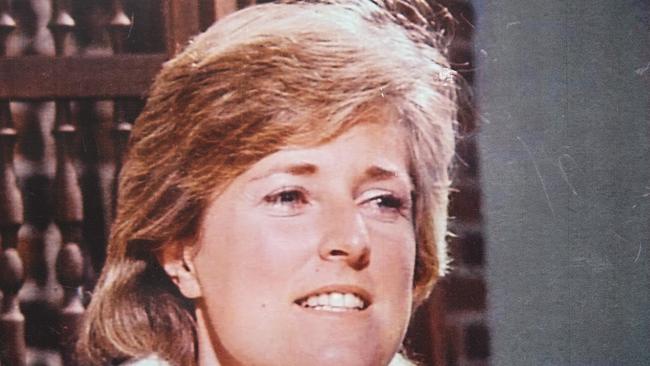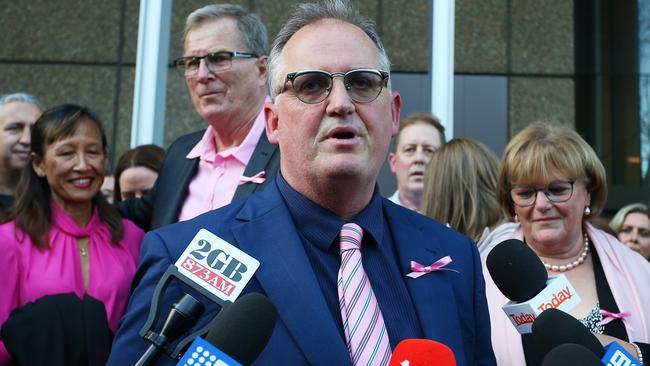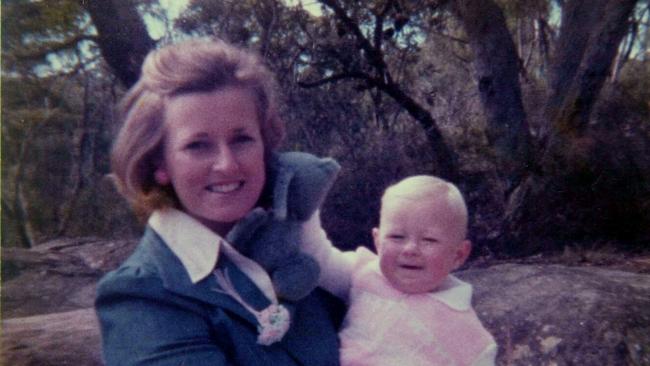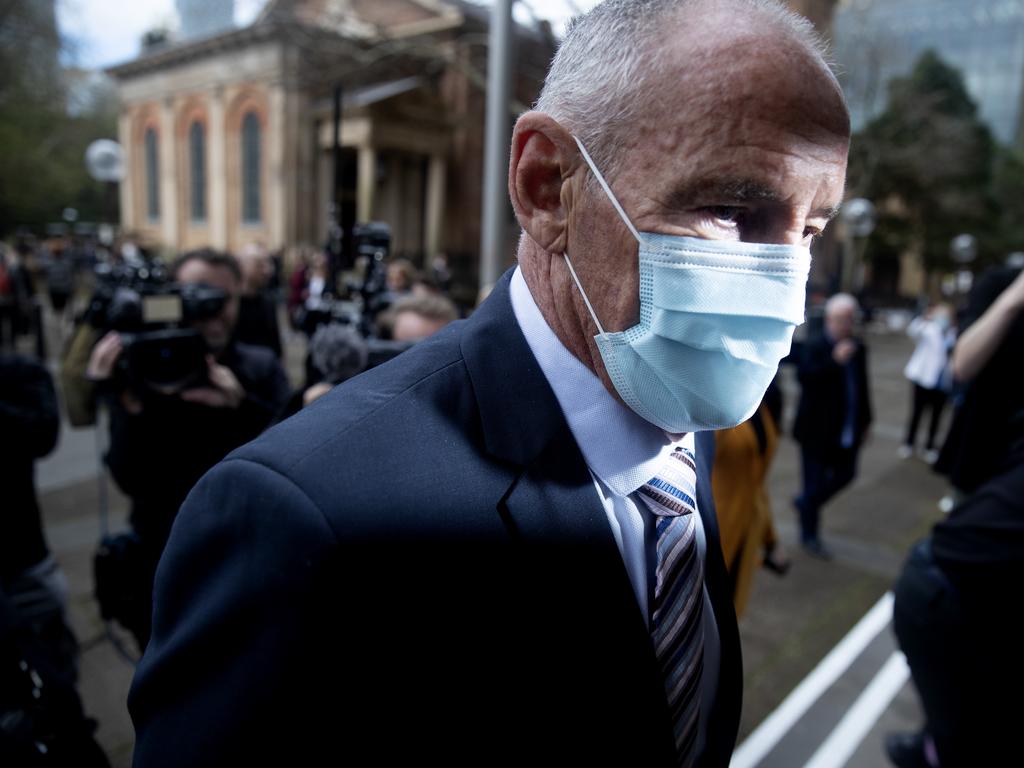
Her brother Greg Simms and sister Pat Jenkins treasure this vivid memory of her colour preference.
Even her scheming husband Chris knew at least this much about the personal choice of a wife he treated with contempt.
He claimed Lyn had pink shorts on 40 years ago when, he insists, she left him during a shopping outing – and stayed away. Lyn’s love of pink was honoured by her loved ones in the Supreme Court in Sydney on Judgment Day, Tuesday, August 30, 2022.
Her family and friends – and even some who had never met her yet remain deeply moved by her tragic story – came together in tribute.
Pink was Lyn’s colour, but her fate, in early January 1982, is black and white. Murdered in cold blood – that’s the people’s verdict.
And in his detailed judgment, Ian Harrison, the trial judge in Chris Dawson’s murder trial, agreed.
Yet Lynette Joy Dawson’s life, her marriage and her 40-year case are much more than anything Justice Harrison can summarise. They are now a touchstone for women who recognise domestic violence, grooming, coercive control and blame-shifting. It has been echoed around the world. Millions of people identify with something about Lyn. They acknowledge her experiences. Some of these people thank Lyn, a woman they never met, for helping them see a way out of their own destructive relationships.
Without reference to the judgment, here are some of the facts and circumstances that, finally, propelled the Office of the Director of Public Prosecutions in Sydney in December 2018 to change course, back police in a murder charge and take Dawson to trial.
Four years later, and four decades after her disappearance, here we are.
The extraordinary love shown by Lyn for her two children made the idea she would leave an absurdity to those who knew her.
Her bond with those little girls was stronger because of her desperation for several years when she was unable to conceive.
Surgery ended her heartbreak at being childless through much of her 20s.
The birth of Shanelle and then her sister two years later changed Lyn’s life. She wouldn’t have left her children. And though it is not often said, she wouldn’t have left Chris or ended their marriage, either, in my view.
Her constant forgiveness in the face of frequent humiliation must have contributed to her demise. If their marriage was going to fall apart formally, he’d have to be the one to take that decisive action.

Lyn just kept absorbing the pain. She wanted her little family to stay together, in spite of everything. The idea she would voluntarily take herself away – an action completely out of character – is extraordinary to all who remember her.
It becomes more extraordinary with each inconceivable layer: starting a new life with no job or money or car or capital assets; leaving no trace, not one documentary hint of her identity or existence; making no contact with anyone except, according to Dawson, him – the husband who had betrayed, humiliated and hurt her.
All of it rings entirely false. It always did. Except to police back in the 1980s.
The fact they immediately wrote her off as a runaway wife and mother without any questioning of the bizarre behaviour of her husband at that time is almost criminal in itself.
Dawson’s obsessive lust over a schoolgirl half Lyn’s age – a teenager with whom he’d already tried, unsuccessfully, to start a new life in Queensland – was all-consuming.
A fortnight after Dawson abandoned their Christmas 1981 runaway venture to Queensland, everything he had wanted suddenly dropped in his lap.
Lyn was out of his life – forever, as it turned out – leaving him with the two children, the beautiful Bayview home on Sydney’s northern beaches and his bank accounts untouched.
Implausible
Powerful motive for a premeditated killing? That was the backbone of the prosecution case from the outset in the murder trial in May, June and July this year.
Along with witness accounts of Lyn’s bruises, of Dawson seen handling her roughly behind closed doors, of her concern that his anger towards her was visceral, and of him seeking a hit man.
The evidence was overwhelming that he hated Lyn, his high school sweetheart, around the time she vanished.

She stood in the way of a teenager with whom he was besotted. A younger, slimmer partner.
And his murder trial heard a phrase that encapsulated it: “Out with the old. In with the new.”
Long before the trial, two coroners who held separate inquests in 2001 and in 2003 recommended that the DPP in NSW should launch a prosecution for murder of a “known person” – Christopher Michael Dawson.
The two coroners and northern beaches detective Damian Loone knew that Dawson’s story – “We had a rough patch, we went to marriage counselling, it seemed to work, then she decided to up and leave and never come back” – always sounded unbelievable, particularly with the backdrop of the teenager and everything else.
Inexplicable
Dawson stretched and snapped the bounds of credibility when he insisted he was committed to revitalising the marriage.
In this guise, he had somehow become the newly dutiful husband. According to Dawson, Lyn must have suddenly altered her plan to meet him, their daughters and her mother, Helena, at Northbridge Baths, where Dawson was a part-time lifesaver on that Saturday, January 9, 1982.

He said he’d dropped her at the Mona Vale bus stop early that morning. She took no suitcase, no jewellery.
Lyn must have changed her mind soon after, he claimed, abandoning him forever.
And she decided to do all this just hours after the marriage-counselling, he said. While out shopping in those pink shorts.
And what of his claims to police and to her mother that Lyn had told him she was up the central coast with friends?
Lyn didn’t drive. Dawson had spent hours teaching JC, the babysitter, to drive, but not his wife.
Nobody knew of any friends on the central coast with whom Lyn would be comfortable after inexplicably leaving her family.
In the 40 years since, no one has come forward to say: “We’ll clear up this internationally renowned mystery; we are the friends Lyn was with after she left her family on that day in January 1982.”
Infuriating
Dawson’s subsequent actions always seemed impossible to reconcile with those of a man worrying over a missing wife.
His five-hour drive to collect the groomed teenager, JC, from her schoolies event on the central coast in January 1982 – and then settling her into the marital bed in the family home just days after Lyn had “left” for, in his words, “a few days away” – makes a mockery of his claims about wanting to repair the marriage.
His actions should have fuelled grave suspicions back then.
Let’s assume he told the truth about her saying she needed to be away for a few days.
What did he intend to tell Lyn if, hypothetically, she had returned from the central coast after a few days of solitary rest and then discovered JC in her clothes, jewellery and bed?
Deputy State Coroner Carl Milovanovich found in 2003 that Lyn was already dead before Dawson’s teenage former student was driven back to the northern beaches and the house at Bayview.
His subsequent trickery and lies have, strand by strand, only made the tangled web around him look worse. Stickier.
In the early 2000s and for the years after as new evidence briefs were taken by police to the DPP, the prosecutors led by Nicholas Cowdery QC repeatedly refused to run the case to trial. Cowdery in 2018 suggested as a hypothesis that Lyn could still be alive.
That it took so many years for the criminal justice system to do its job properly and put it before a jury is one of the most infuriating chapters of all.

Investigation
This case has been black and white for me since 2018 when I investigated Lyn’s disappearance for The Teacher’s Pet podcast series.
I had read the underlying police brief of evidence with its witness statements from the late 1990s. It was fortunate that Greg Simms still had this brief – and shared it with me.
For the podcast series, I set about trying to understand every angle in the case, finding and interviewing witnesses from the 1980s and ’90s, and many others who were not mentioned in the police brief of evidence but who knew things.
The credibility of these many decent, honest people who knew that Lyn would never leave her kids took this case from a murky grey to stark black and white in my eyes.
The italicised words below start episode 1 of The Teacher’s Pet.
There is a hilltop of rugged beauty above Sydney’s sunny northern beaches.
A place of dense bush and rocky outcrops, and long driveways snaking across acreage properties to comfortable family homes.
It is noisy here at Bayview in summer. Male cicadas crawl out of the soil, then violently deform their bodies to pull off a complex vibration – and an ear-splitting buzzing. Nature’s summer soundtrack can be deafening. Maddening.
The secretive cicadas are desperate to find a female for a frenzy of mating. It will ultimately be fatal.
I wrote these words at a time I remember well, sitting at the kitchen table in our family home in Brisbane on a warm March afternoon in 2018.
Folders and documents from a murder file called “Lyn Dawson” were strewn the length and breadth of the table.
The balance of the folders lay in no particular order in a cardboard box on the floor.
For as long as I’ve been a journalist, I’ve struggled with the start of a story. The opening paragraphs. The intro.
The more profound or moving the story, the greater the struggle to find the right words.
It would be my first podcast. By March 2018, I had been working on it for five months already, travelling to Sydney and its northern beaches, Newcastle and towns in-between.
Sitting down for long interviews with Lyn’s siblings and friends, with Lyn’s daughter Shanelle, former students, former cops, former teachers.
Talking to people who knew something. Or who thought they might know someone who knew something. Even traipsing across ground, in national parks, which might hide a body.
I know now why I was struggling with the opening words more than usual.
Lyn’s story is vast. Much more than anything I’d investigated and reported before.
It is deeply sad.
It is shockingly unjust.
And for the previous 17 years, I must have known or at least suspected this.
Because the podcast was my second immersion in Lyn’s case. The first immersion was at the time of the first inquest back in 2001 when I read a snippet about the inquest and then went from Brisbane to Sydney to meet the detective, Damian Loone.
At a northern beaches police station, he let me read the material that had been part of that first inquest.
My subsequent feature-length newspaper article about Lyn having disappeared – and her husband being suspected of murder at a time he was infatuated with his former student-cum-babysitter – flickered briefly over a weekend before Easter in 2001.
And then it went away.
Injustice
In 2018, 17 years later as I examined documents and police files and reflected on the many hours of interviews I had recorded for a podcast, I felt I had got close to the truth.
It was maddening because the injustice seemed so plain.
I found myself feeling righteously motivated while also privileged to have a chance to shine a light on this case … perhaps try to right what Lyn’s family and friends knew to be a terrible wrong.
By getting the whole story told in a podcast, we might help. Giving people who knew Lyn a voice – and giving Lyn her voice – would be crucial.
By March 2018, my MacBook Air’s storage capacity was at its limits with huge audio files – recordings using a $250 hand-held device for dozens of hours of conversation with people who once knew Lyn or Dawson or both.
They brought this doting wife and mother to life once more, describing her laughter, her love, her warmth, hopes and fears.

Lyn was a spirited child in a happy family who grew up in a stucco home perched high at an idyllic place called Clovelly in Sydney’s eastern suburbs, where the sound of the surf and waves of the Pacific Ocean crashing endlessly on rocks and coastline are reassuring.
Where the briny tang of salt in the fresh air and on tanned skin after a swim on a hot, sunny day are summer’s simple rewards.
They told me of a popular and pretty teenager with a big heart and a radiant smile who met a boy called Chris, an identical twin, with a natural winner’s athleticism, perfect physique and handsome looks.
As a young woman, she would train and work as a nurse, marry her first love, Chris, and worship the ground he walked on.
They would move to that hilltop of rugged beauty on Sydney’s northern beaches, build and decorate a beautiful yet isolated family home just a few hundred metres from where Chris’s twin, Paul, and his wife, Marilyn, built theirs on the same stretch, Gilwinga Drive.
Lyn was ecstatic at being a young mother after years of anxiety at being unable to have kids.
She was bewildered to find herself in a failing marriage with a man who would no longer touch her intimately, found fault with her incessantly and drove her to tears with his mocking rhymes about her and his bullying ways and infidelity.
But all the while, Lyn was a mother who would never be voluntarily parted from the two daughters she adored, who would shoulder any burden to rescue her marriage to the man she also adored.
Until one steamy January weekend in 1982, when she suddenly disappeared, never to be seen by her loved ones again.
The secretive cicadas are desperate to find a female for a frenzy of mating. It will ultimately be fatal.
Julie Andrew, Lyn’s neighbour and friend, said: “The best way to dispose of a body when you live in the bush is to put it in the bush. And that’s what I think he did on the Friday night.”
Lyn is long gone, but millions of people have heard her voice and they carry her story in their hearts and minds.
Lyn didn’t die for nothing.







Lyn Dawson loved wearing pink.